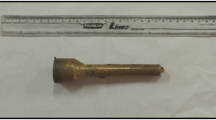Abstract
The influence of annealing on the formation of nanocrystalline of CuNi alloy surface was investigated by evaluating the microstructure, mechanical properties, and corrosion behavior of as-processed condition (using severe plastic deformation by punching process) and its annealed condition. It was observed that the microstructure changed after annealing of punched sample using an atomic force microscope. Mechanical resistance and corrosion resistance were also characterized using nanoindentation test, electrochemical test, electron work function, and microtribometer test. It was found that the punched and subsequent annealed samples have increasing hardness, elastic behavior (η), and corrosion resistance. Therefore, annealing can lead to the final formation of nanocrystalline and corresponding stability of grain boundary, which are responsible for the increasing mechanical properties and corrosion resistance.





Similar content being viewed by others
References
Valiev RZ. Nanostructuring of metals by severe plastic deformation for advanced properties. Nat Mater. 2004;3(8):511.
Valiev RZ, Islamgaliev RK, Alexandrow IV. Bulk nanostructured materials from severe plastic deformation. Prog Mater Sci. 2000;45(2):103.
Tao NR, Wang ZB, Tong WP, Sui ML, Lu J, Lu K. An investigation of surface nanocrystallization mechanism in Fe induced by surface mechanical attrition treatment. Acta Mater. 2002;50(18):4603.
Zahid GH, Huang Y, Prangnell PB. Microstructure and texture evolution during annealing a cryogenic-SPD processed Al-alloy with a nanoscale lamellar HAGB grain structure. Acta Mater. 2009;57(12):3509.
Islamgaliev RK, Chmelik F, Kuzel R. Thermal stability of submicron grained copper and nickel. Mater Sci Eng A. 1997;237(1):43.
Valiev RZ, Mulyukov RR, Ovchinnikov VV. Direction of a grain-boundary phase in submicrometer-grained iron. Philos Mag Lett. 1990;62(4):253.
Valiev RZ, Sergueeva AV, Mukherjee AK. The effect of annealing on tensile deformation behavior of nanostructure SPD titanium. Scr Mater. 2003;49(7):669.
Valiev RZ, Ivanisenko YV, Rauch EF, Baudelet B. Structure and deformation behaviour of Armco iron subjected to severe plastic deformation. Acta Mater. 1996;44(12):4705.
Zou SK, Gong SL, Guo EM. Surface profile and microstructure of laser peened Ti–6Al–4V. Rare Met. 2012;31(5):430.
Yamakov V, Wolf D, Phillpot SR, Mukherjee AK, Gleiter H. Dislocation processes in the deformation of nanocrystalline aluminum by molecular dynamics simulation. Nat Mater. 2002;1(1):45.
Swygenhoven VH, Derlet PM, Froseth AG. Stacking fault energies and slip in nanocrystalline metals. Nat Mater. 2004;3(6):399.
Mao XY, Fang F, Yang F, Jiang JQ, Tan RS. Effect of annealing on microstructure and properties of Cu-30Ni alloy tube. J Mater Process Technol. 2009;209(4):2145.
Fu YB, Cui J, Li TJ. Crystal orientation and corrosion resistance of CuNi10Fe1Mn alloy billet under rotating electromagnetic field. Rare Met. 2012;31(6):552–5.
Ashcroft NW, Mermin ND. Solid state physics. New York: Saunders College Publishing; 1976.
Bockris JOM, Khan SUM. Surface electrochemistry: a molecular level approach. New York: Springer; 1993.
Milosev I, Metikos-Hukovis M. The behaviour of Cu–xNi (x = 10 wt% to 40 wt%) alloys in alkaline solutions containing chloride ions. Electrochim Acta. 1997;42(10):1537.
Aust KT, Erb U, Palumbo G. Nanostructured materials—processing, properties and potential applications. New York: William Andrew Publishing/Noyes; 2002.
Acknowledgments
This study was financially supported by the Scientific Research Startup Foundation of Nanjing Institute of Technology for Introducing Talents (No. YKJ201008), the Industrialization of Scientific Research Promotion Projects of Colleges and Universities in Jiangsu Province (No. JHB2011-25), and Innovation Foundation of Nanjing Institute of Technology (No. CKJB201206).
Author information
Authors and Affiliations
Corresponding author
Rights and permissions
About this article
Cite this article
Mao, XY., Wang, ZZ., Zhao, XM. et al. Microstructure, mechanical, and corrosion properties of surface of CuNi alloy produced by punching and annealing treatment. Rare Met. 32, 134–138 (2013). https://doi.org/10.1007/s12598-013-0031-3
Received:
Revised:
Accepted:
Published:
Issue Date:
DOI: https://doi.org/10.1007/s12598-013-0031-3




